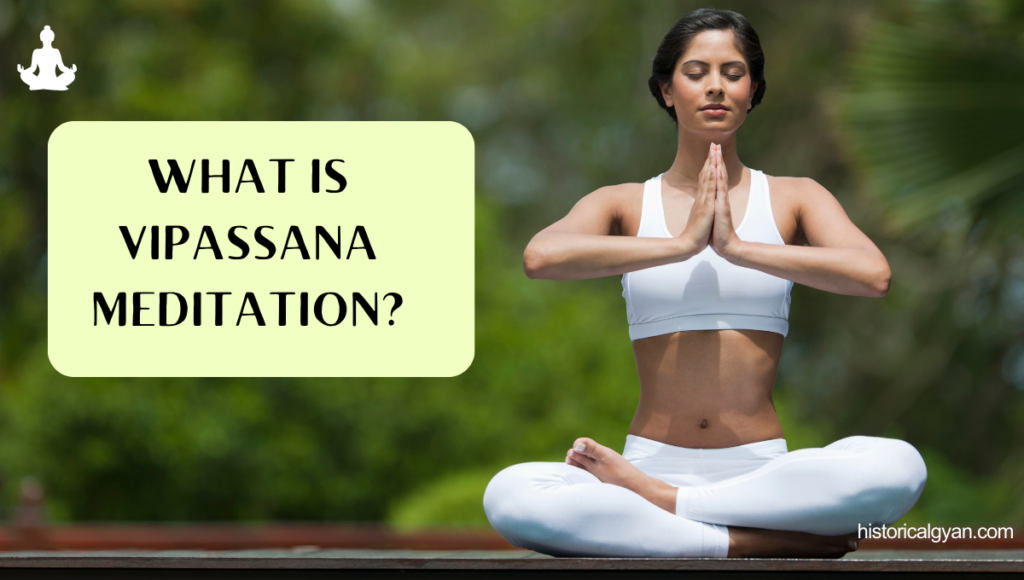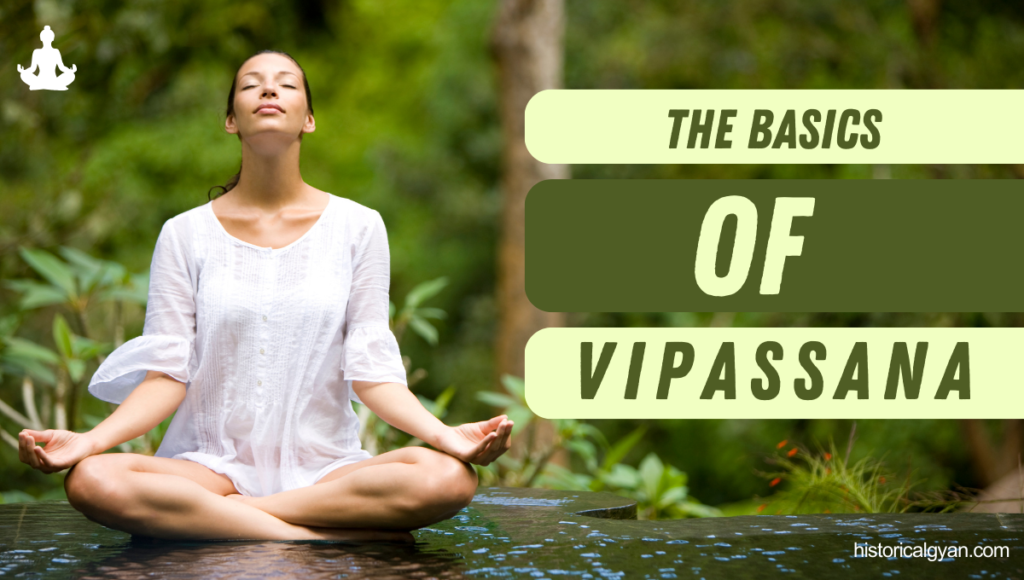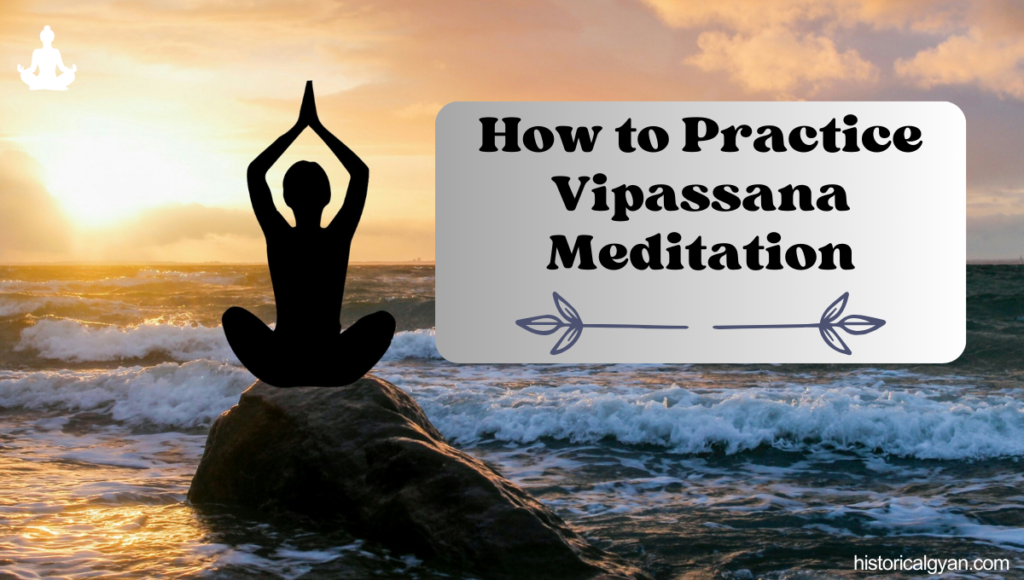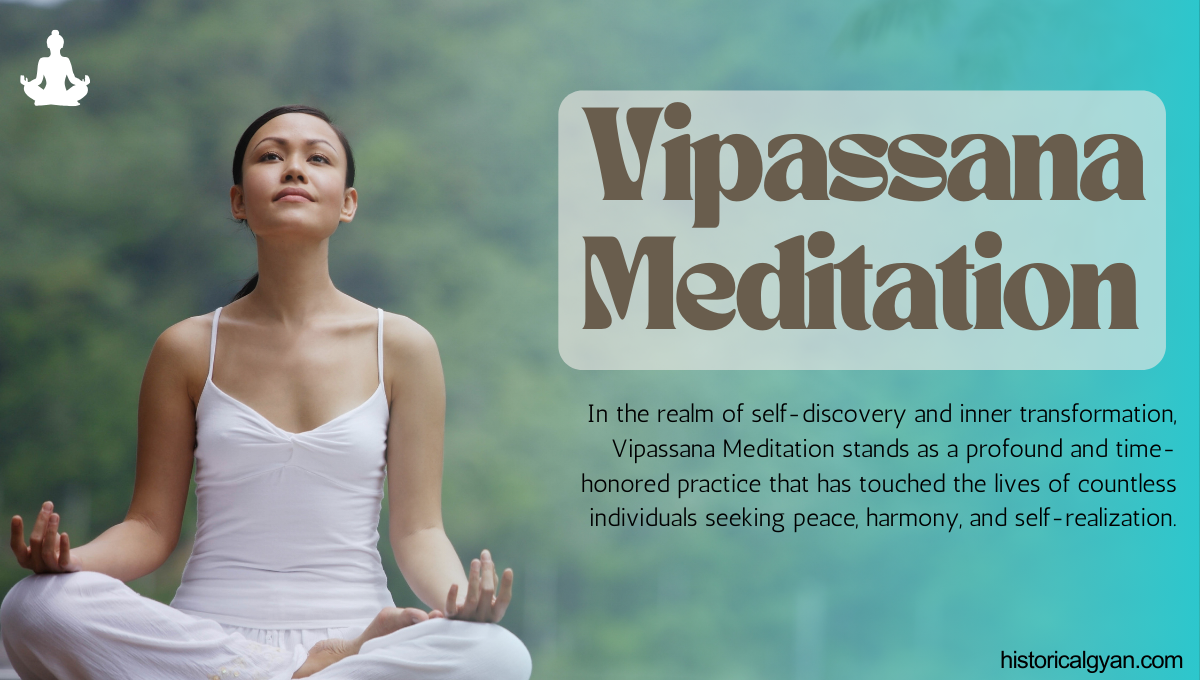In the fast-paced world we live in today, finding a way to achieve inner peace, mental clarity, and emotional balance is of utmost importance. The demands of our daily lives often leave us stressed, anxious, and disconnected from our true selves. It’s in times like these that ancient meditation techniques like Vipassana can offer a path to profound self-discovery and transformation.
What is Vipassana Meditation?

Vipassana, which translates to “seeing things as they are,” stands as one of India’s oldest and most revered meditation practices. Aspirants often embark on ten-day courses dedicated to the teachings of Vipassana, guided by experienced mentors. It’s important to note that Vipassana, much like all meditation forms, extends a warm invitation to individuals from diverse faiths and nationalities.
This practice transcends the confines of belief systems, epitomizing non-sectarianism and eschewing any association with paranormal or mystical ideologies. In this regard, it harmoniously aligns itself with various religious and philosophical perspectives.
Embarking on the path of Vipassana is akin to embarking on a journey of self-discovery. It provides a unique opportunity to personally encounter the timeless wisdom encapsulated in ancient teachings. The primary objective of this practice is the complete purification of the mind, coupled with the cultivation of virtues such as compassion, equanimity, and empathy.
In essence, Vipassana meditation beckons individuals to embark on a profound journey of introspection and self-improvement, offering a gateway to mindfulness and a deeper understanding of the self and the world.
The Basics of Vipassana.

In other meditation practices, you might use verbalization or visualization along with breath awareness to calm the mind. This approach might offer immediate concentration and relief. However, the goal of Vipassana is not just to calm the mind; it is to purify it deeply, transforming ingrained behavioral patterns.
1. Understanding the Technique
Vipassana starts with the observation of your breath. You simply observe the incoming and outgoing breath as it naturally occurs. It’s important to note that this is not a breathing exercise, and you should not try to control your breath. The key is to maintain awareness of your breath’s natural rhythm.
2. Overcoming Initial Challenges
On the first day, you may encounter various challenges, such as physical discomfort, restlessness, or mental resistance. These challenges arise because your body and mind are not accustomed to this new practice. Your body and mind might initially revolt against this unfamiliar activity.
3. The Importance of Patience
Patience is crucial during this phase. Understand that discomfort is a temporary reaction to change. Your body and mind are adjusting to a new way of being. By persistently and patiently working through these initial discomforts, you pave the way for profound inner transformation.
How to Practice Vipassana Meditation
Vipassana meditation is typically undertaken during retreats, where participants engage in a structured course guided by meditation experts. Many of these courses are available online, often free of charge, thanks to support from donations.
The practice of Vipassana involves several key steps:
- Sila (Morality): The journey begins with the cultivation of morality (sila). Participants commit to five moral precepts, refraining from actions that cause harm. These precepts include abstaining from killing, stealing, engaging in sexual misconduct, lying, and using intoxicants. Observing these precepts helps calm the mind and create a conducive environment for meditation.
- Anapana Meditation (Concentration): During the initial three and a half days of the retreat, students focus on Anapana meditation, concentrating their attention on the breath. This practice aids in developing samadhi (concentration) and gaining control over the restless mind. Establishing morality and achieving mental control are essential prerequisites for the deeper stages of meditation.
- Vipassana Meditation (Insight): The final six and a half days of the retreat are dedicated to Vipassana meditation. Here, participants penetrate their entire physical and mental structure with the clarity of panna (wisdom and insight). This practice involves breaking down mental barriers to observe one’s true self, ultimately purifying the mind.
By following this progressive path of morality, concentration, and insight, Vipassana practitioners aim to gain profound insights into the nature of reality and achieve inner purification.
What are the benefits of Vipassana Meditation?

Stress Alleviation
Vipassana meditation serves as a powerful tool for mitigating stress. By nurturing mindfulness and heightened awareness, individuals can effectively manage and reduce their stress levels. This practice encourages people to observe their thoughts and emotions without passing judgment, enabling them to detach from stressors and uncover inner serenity.
Anxiety Relief
In our fast-paced contemporary world, anxiety has become increasingly pervasive. Vipassana meditation offers a natural remedy for anxiety by assisting individuals in becoming more attuned to their thoughts and feelings. Through consistent practice, one can cultivate the skills to identify and alleviate anxiety, fostering a sense of peace and tranquility.
Enhanced Mental Wellness
Vipassana meditation embodies a holistic approach to mental well-being. It enhances emotional regulation, self-awareness, and resilience. By delving deep into one’s inner world and comprehending thought patterns, practitioners can attain greater mental clarity and emotional stability, ultimately resulting in an overall improved state of mental health.
Promotion of Neuroplasticity
Neuroplasticity, the brain’s remarkable capacity to adapt and reorganize itself, can be promoted through Vipassana meditation. This practice encourages the formation of new neural connections, potentially leading to heightened cognitive function, improved memory, and increased creativity.
Effective in Addressing Addiction
Vipassana meditation has proven to be a valuable component of addiction treatment programs. It aids individuals in confronting and conquering addictive behaviors by addressing the root causes of addiction, including cravings and emotional triggers. Through mindfulness practice, individuals can develop the strength and resilience required to break free from addiction.
Heightened Focus and Concentration
Regular meditation, including Vipassana, sharpens focus and concentration. By training the mind to remain present and attentive, individuals can become more productive in their daily tasks and enhance their ability to achieve their goals.
Improved Emotional Control
Vipassana meditation equips individuals with the skills to effectively manage their emotions. By observing their feelings without attachment, they can gain control over emotional reactions. This emotional regulation leads to healthier relationships and a more balanced emotional state.
Increased Self-Understanding
Self-awareness is a foundational element of personal growth and development. Vipassana meditation encourages introspection and self-reflection, aiding individuals in gaining a deeper understanding of themselves, their behaviors, and their aspirations. This heightened self-awareness empowers individuals to make positive changes in their lives.
Enhanced Compassion and Empathy
As individuals become more attuned to their own thoughts and emotions through Vipassana, they also develop a greater sense of empathy and compassion for others. This heightened understanding of human nature fosters more meaningful and fulfilling relationships.
Physical Health Benefits
In addition to mental and emotional benefits, Vipassana meditation can also have positive effects on physical health. It has been associated with lower blood pressure, improved immune system function, and better sleep patterns.
Tips for Beginners of Vipassana Meditation
Tips for beginners If you’re just starting with Vipassana meditation, these beginner tips can enhance your practice:
- Utilize Guided Meditations: For a structured approach, consider listening to Vipassana meditation recordings. You can access free guided Vipassana sessions on platforms like YouTube.
- Explore the Dhamma.org App: Download the Dhamma.org app, a dedicated Vipassana meditation application. It provides audio recordings, informative articles, and resources to help you locate local Vipassana courses.
- Attend a Vipassana Course: For personalized guidance, think about participating in a Vipassana meditation course. These courses are often available at yoga studios and spiritual centers, allowing you to receive hands-on instruction.
- Set a Meditation Timer: During your initial sessions, use a timer to manage your meditation duration. Gradually increase the time as you grow more comfortable with the practice.
- Minimize Distractions: To minimize interruptions, silence your phone and inform others in your household that you’ll be meditating.
- Practice Patience: Particularly if you’re new to meditation, remember that it takes time and consistent practice to master the art of meditation and enjoy its benefits.
How to do Vipassana meditation:

Tips for Practicing Vipassana Meditation
Here are some suggestions for embarking on your solo Vipassana Meditation journey. Commencing a Vipassana meditation routine may appear intimidating at first, but with proper guidance and unwavering commitment, it can be profoundly gratifying. If you’re ready to commence your Vipassana meditation practice, here are some recommendations to facilitate your initiation. Keep in mind that integrating this routine into your life will require time, and you can always adapt the subsequent steps to suit your unique requirements.
Explore these pointers for engaging in Vipassana meditation:
- Discover a serene location: Your foremost priority is locating a tranquil space where you can engage in Vipassana meditation. This space could be an unused room in your dwelling, a peaceful nook in your garden, or even a secluded area in a nearby park.
- Establish a schedule and select a suitable time: Develop a regular timetable for your practice. Set aside a few minutes each day for your Vipassana meditation routine. Maintaining consistency and adhering to your schedule will aid in nurturing a robust meditation practice and enhance the efficacy of your routine.
- Commence with the fundamentals: Before immersing yourself in a complete Vipassana meditation routine, it’s wise to commence with fundamental meditation exercises. Begin by focusing on your breath and counting your breaths. Pay attention to the physical sensations of your breath, including the ascent and descent of your chest and the motion of your lungs. As you progress, you can gradually elevate the complexity of your practice.
- Seek a mentor: If you aspire to maximize the advantages of your Vipassana meditation practice, consider finding a qualified instructor who can furnish guidance and instruction. A mentor can teach you the proper techniques and help you sustain your motivation. Please be aware that your mentor may not be in physical proximity.
- Contemplate utilizing various meditation applications: Meditation apps can offer guidance and hold you accountable. Keep in mind that your mentor may not be physically accessible. You might also want to explore Insight Timer, a meditation app offering an extensive collection of free meditation resources, to ascertain what suits your needs.
- Cultivate patience and progress at your own tempo: Don’t become disheartened if you don’t sense immediate advancement. With patience and unwavering dedication, you’ll eventually start reaping the rewards of your practice.
By adhering to these recommendations and demonstrating a steadfast commitment to your practice, you can initiate the journey to experience the myriad benefits of Vipassana meditation.
The Universality of Vipassana
One remarkable aspect of Vipassana meditation is its universality. It transcends cultural, religious, and sectarian boundaries. Unlike some other meditation practices that involve chanting specific words or visualizing deities, Vipassana focuses on universal truths that are accessible to all.
A Universal Approach
The Vipassana technique encourages practitioners to work with the reality they experience within the framework of their own bodies. It does not require adherence to any particular religious belief or dogma. This universality makes it accessible to people from all walks of life.
The Duality of Thoughts
This mental journey is accompanied by a distinct duality of thoughts – pleasant and unpleasant. When the mind recalls pleasant memories or envisions favorable futures, it generates a positive response within us. We like it, and this liking can quickly transform into craving. We desire for these pleasant experiences to recur, and as we cling to this desire, our minds lose balance, leading to agitation.
Conversely, when the mind ventures into the territory of unpleasant memories or foresees unfavorable futures, it triggers a negative response. We dislike it, and this aversion can evolve into aversion or even hatred. We develop a strong distaste for these thoughts, and once again, the equilibrium of our minds is disturbed, resulting in turmoil.
The Ultimate Goals of Vipassana Meditation:
The ultimate goal of Vipassana meditation is not just to achieve a calm and concentrated mind, although that is a valuable byproduct. The primary aim is to purify the mind at its deepest level. This involves changing the habitual patterns of the mind that lead to agitation, negativity, and suffering.
Vipassana meditation, with its roots in ancient wisdom, holds a spectrum of profound objectives that transcend the boundaries of the individual self. Let’s delve into these ultimate goals:
1. The Path to Self-Realization: Vipassana is a journey within, a path to realizing the true nature of oneself. By observing thoughts and emotions impartially, practitioners come to intimately understand their inner world, fostering self-awareness and self-realization.
2. The Path to Inner Peace: Inner peace is a cherished goal of Vipassana. Through the practice of observing the breath and mental phenomena, individuals gradually attain a state of inner tranquility. This inner peace becomes a sanctuary amidst life’s turmoil.
3. Purifying the Mind: Vipassana seeks to purify the mind from its habitual patterns and impurities. By facing the mind’s contents directly, without attachment or aversion, practitioners cleanse the mind, allowing it to shine with clarity and purity.
4. Universal Healing: Vipassana meditation extends its healing touch not only to the individual but to the universal consciousness. As individuals purify themselves, their positive vibrations resonate and contribute to the greater healing of humanity.
5. Acceptance and Balance: The practice of Vipassana fosters acceptance of what is. By observing the ever-changing nature of thoughts and sensations, individuals learn to accept life’s impermanence. This acceptance, in turn, brings balance and equanimity.
6. Connecting with the Universal Law: Vipassana invites individuals to connect with the universal law of nature. By observing the natural breath and the impermanent nature of all phenomena, practitioners align themselves with the cosmic order.
7. Observing the Mind-Matter Connection: Vipassana allows practitioners to explore the intricate connection between the mind and matter. By observing how thoughts and sensations are intertwined, individuals gain insights into the profound interplay of consciousness and the physical world.
8. Living in the Present: Perhaps one of the most cherished goals of Vipassana is the ability to live fully in the present moment. By observing each breath and each sensation as it arises, individuals break free from the shackles of past regrets and future anxieties, embracing the richness of the here and now.
Mastering Your Vipassana Meditation Retreat:
Navigating the 10-Day Challenge
Embarking on a 10-day Vipassana meditation retreat is no small endeavor. It’s akin to entering a self-imposed prison of the mind, where you commit to staying within the confines of the retreat center for the entire duration. This commitment is crucial to the success of your meditation practice, and it’s essential to be prepared mentally and emotionally for this challenging yet transformative experience.
The First Day of Your Vipassana Journey
The first day of a Vipassana meditation retreat marks the initiation of a profound inward journey. As you step into this ten-day immersion, you are greeted with the knowledge that you have nine more days ahead, each offering an opportunity for self-transformation. Your task during this retreat is to labor diligently, striving to achieve the best results during your stay. Here, we’ll guide you through what to expect during this initial phase.
The Challenge of the First and Sixth Days
In the realm of Vipassana retreats, the first and sixth days often prove to be the most challenging. As you step into this journey, you may encounter restlessness and doubt creeping in. It’s crucial to acknowledge these feelings and confront them with determination.
On the first day, as the retreat begins, you might be filled with excitement and anticipation. But as the initial novelty wears off, you may start feeling the weight of the commitment. Doubts can arise, and you might entertain thoughts of leaving the retreat prematurely. This is a common experience, and it’s essential to remember why you embarked on this journey in the first place.
By the sixth day, you’ve reached the midpoint of the retreat. It’s here that a more profound operation within your psyche begins. You may find yourself facing deep-seated emotions and mental patterns that have been hidden beneath the surface. The intensity of this inner work can be unsettling, and the desire to run away may resurface. This is the critical juncture where your determination plays a pivotal role.
The Power of Determination
During a Vipassana retreat, your determination is your strongest ally. It’s what keeps you grounded, focused, and committed to the process. Here’s why determination is crucial:
- Staying the Course: When you face challenges or restlessness, your determination reminds you of your commitment to the 10-day retreat. It helps you stay the course even when the going gets tough.
- Overcoming Doubts: Doubts are natural, especially in the initial days. Determination serves as a counterforce to doubt, pushing you to confront these doubts head-on and continue your practice.
- Inner Strength: The process of meditation often involves confronting aspects of yourself that you’d rather avoid. Determination provides the inner strength needed to face these inner demons and emerge stronger.
- Respecting Time: Your determination ensures that you respect the schedule and timetable of the retreat. Time is a precious resource during a meditation retreat, and every minute is an opportunity for growth.
Adherence to Rules and Timetable
Another crucial aspect of a successful Vipassana retreat is strict adherence to the rules and timetable. These rules are in place to create an environment conducive to deep meditation and self-discovery. Here are some key points to remember:
- Punctuality: Arriving on time for meditation sessions is of utmost importance. Being late not only disrupts your practice but also disturbs the collective energy of the group. Respect the schedule and be punctual.
- Continuous Practice: Meditation periods are not the time to slack off. Commit to the full duration of each session, even if your mind resists. Consistency is key to reaping the benefits of meditation.
- Restraint: Overeating during meal times is counterproductive. Remember that meditation requires a clear and alert mind. Avoid overindulgence, and leave a portion of your stomach empty to facilitate your practice.
- Silence: Maintaining silence is essential. It allows you to go deeper into your practice and respect the inner silence you seek to cultivate. Avoid unnecessary chatter or communication
Maximizing Your Vipassana Experience:
The intensive practice of Vipassana transcends the boundaries of time and culture, offering individuals a transformative journey toward self-realization.
Method One: Cultivating Conscious Awareness
Vipassana meditation, at its core, is the practice of being present in every moment. The first technique involves cultivating awareness in your everyday actions, body, mind, and heart. Imagine walking with consciousness, where every step is a deliberate act of mindfulness. Whether you wave your hand or take a leisurely morning walk, be completely conscious of your movements. Your body becomes an instrument, intricately connected with the symphony of existence.
When eating, enjoy the experience by being aware of each bite and the complex processes required for nutrition. While taking a bath, feel the coolness of the water, the drops dancing on your skin and the intense pleasure it brings. The key is simple: just be aware, without judgment or evaluation. This state of pure awareness frees you from entanglement with thoughts and emotions, allowing you to observe them as a distant witness.
Second method: using the breath
The second method of Vipassana meditation focuses on breathing. Breathing is an intimate connection to life itself, and by becoming aware of it, you tap into a deep source of energy. As you inhale, notice your belly slowly rising, and as you exhale, feel it settling. Your belly, closely connected to the source of life, rises and falls with each breath, symbolizing the ebb and flow of life energy.
This method, although seemingly simple at first, has immense power. Like the first method, you will achieve a calm mind and heart, but this time, by focusing only on the rise and fall of your abdomen. The breath acts as a bridge between your physical and mental realms, harmonizing your inner being.
Third Method: Nasal Awareness
The third and final technique involves focusing your attention on the breath’s journey through your nostrils. As the breath comes in, focus on the cool touch it provides to your nostrils. As it comes out, notice the sensation as it comes out. This method sharpens your awareness from the stomach to the other end, increasing your ability to concentrate.
In this practice, you delve deeply into the subtleties of the breath, sharpening your sensory perception. By anchoring your awareness to the nostrils, you refine your concentration, paving the way for a calm mind and peaceful heart. This method beautifully combines the previous two methods, and provides an all-round Vipassana experience.
The Importance of Silence
In the realm of Vipassana, silence is not just the absence of external noise; it’s a profound state of inner calm and stillness. Complete silence during meditation is essential for several reasons:
- Enhanced Focus: Silence helps you concentrate on your breath or chosen meditation technique. External distractions can disrupt this focus, hindering your progress.
- Self-Reflection: Silence allows you to delve deeper into your thoughts and emotions. It’s a space where you can confront your inner world honestly.
- Mindful Observation: Silence enables you to observe your thoughts without judgment. This self-awareness is crucial for personal growth.
- The Five Precepts: In many meditation practices, adhering to ethical principles like truthfulness is vital. Silence ensures you don’t inadvertently engage in falsehoods during your practice.
The Dangers of External Communication
During a meditation retreat or even solitary practice, it’s essential to avoid external communication. Engaging in conversations with fellow practitioners can be detrimental to your progress. Here’s why:
- Disturbance to Others: Meditation centers often emphasize complete silence to create an ideal environment for inner exploration. Conversations can disrupt not only your practice but also the experience of others.
- Feeding the Chattering Mind: Engaging in conversations before or after meditation sessions can fuel your chattering mind. The thoughts and emotions from these interactions may linger, hindering your inner silence.
- Maintaining Ethical Commitments: To truly benefit from meditation, it’s crucial to uphold ethical commitments. Engaging in casual conversations may lead to untruthfulness, breaking one of the foundational principles of meditation.
The Perils of Mixing Techniques
In the pursuit of inner silence, some practitioners make the mistake of mixing meditation techniques. This can be dangerous and counterproductive. Imagine it as trying to ride two horses simultaneously:
- Habitual Patterns: Mixing techniques can trigger habitual patterns formed from previous practices. It’s like trying to ride both a white and a black horse – it’s risky and can lead to confusion.
- Deep Internal Churning: When you intentionally mix techniques, your mind can become deeply churned. This confusion can be a hindrance to achieving the desired state of inner silence.
- Potential Danger: Teachers often advise against mixing techniques due to the potential danger it poses. It can lead to mental and emotional turbulence that is challenging to navigate.
Cautions in Vipassana Meditation
Here, we must heed some important warnings to ensure a successful journey through this inner exploration. These warnings are akin to the rules and guidelines in a hospital that patients must adhere to:
- Commitment to Stay: Just as a hospital patient must stay for the duration of their treatment, you’ve committed to a ten-day journey of self-discovery. There is no leaving midway; you must see it through.
- Endurance through Agitation: As the days progress, you may encounter mental agitation and restlessness, especially on the second and sixth days. These are not signs of failure but challenges to be faced with unwavering determination.
- Adherence to Timetable: Time is precious in this endeavor. Strictly adhere to the meditation timetable. Every minute counts.
- Consistent Meditation: Three meditation sessions a day, from morning till evening, are crucial. Do not slack off; utilize every opportunity for practice.
- Empty Stomach: Keep a quarter of your stomach empty during meals. Overeating will hinder your meditation progress.
- Maintain Silence: Complete silence is essential. Do not communicate with fellow meditators through speech, gestures, or even glances. Maintain inner silence too; avoid speaking lies, exaggerations, or hiding the truth.
- No Mixing of Techniques: Do not mix this technique with any other. Stay committed to the path you’ve chosen for these ten days.
- Stay Within the Designated Area: The meditation area is your sanctuary. Do not wander outside the designated boundaries.
- Avoid Extraneous Practices: Do not engage in any other practices or rituals during this period. Your focus should be solely on Vipassana meditation.
- Utilize Every Moment: Time is fleeting, and these ten days are a rare opportunity. Utilize every moment to dive deeper into self-awareness.
These warnings and guidelines are essential for your safety and progress. By adhering to them, you’ll harness the power of this technique and unlock the potential for inner peace, harmony, and happiness. Remember, the discomfort you face is the crucible in which real change occurs, and the journey you’re embarking upon is a path to liberation from the shackles of ignorance, craving, and aversion.
May your experience over these ten days be transformative and lead you towards real peace, harmony, and lasting happiness. Embrace the journey with determination and unwavering commitment.
In Conclusion
Vipassana meditation is a profound and universal technique that offers a path to self-realization and inner transformation. It transcends cultural and religious boundaries, focusing on the fundamental truths that connect us all. Through patience, persistence, and dedication, you can unlock the secrets of your own mind and discover the universal law that governs existence. ribs. The discomfort arises because you are observing the natural breath, the bare breath, without any added elements. In other techniques, practitioners often pair breath awareness with reciting a mantra or visualizing a deity. These verbalizations or visualizations can help calm the mind and enhance concentration. However, in this technique, the focus is on purifying the mind deeply, not just at the surface level.

